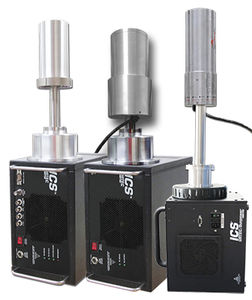
Scintillation detector 905 gamma ray


Add to favorites
Compare this product
Characteristics
- Detected entity
- scintillation
- Technology
- gamma ray
Description
A gamma ray interacting with a scintillator produces a pulse of light that is converted to an electric pulse by a photomultiplier tube (PMT). The PMT consists of a photocathode, a focusing electrode, and 10 or more dynodes that multiply the number of electrons striking at each dynode. A chain of resistors typically located in a plug-in tube base assembly biases the anode and dynodes. Complete assemblies including the scintillator and PMT are available.
The properties of a scintillation material required to produce a good detector are transparency, availability in large size, and large light output proportional to gamma-ray energy. Few materials have good properties for detectors. Thallium-activated sodium iodide [NaI(Tl and cesium iodide [CsI(Tl crystals are commonly used, as well as a wide variety of plastics. CsI(Tl) and plastics have much faster light decay times than NaI(Tl) and are primarily used for timing applications.
The high Z of iodine in NaI(Tl) crystals result in high efficiency for gamma-ray detection. Resolution for a 3-inch diameter by 3-inch length crystal is typically about 7% for 137Cs and slightly worse for larger sizes. The light decay time constant for a NaI(Tl) crystal is about 0.23 µs. Typical charge-sensitive preamplifiers translate this into an output voltage pulse with a rise-time of about 0.5 µs.
Catalogs
No catalogs are available for this product.
See all of ORTEC‘s catalogsRelated Searches
- Monitoring detector
- Hand-held detector
- Compact detector
- Rugged detector
- Integrated detector
- Detector for the food industry
- Continuous detector
- OEM detector
- Nitrogen detector
- USB detector
- Multichannel detector
- Rugged detector
- Gamma detector
- Bluetooth detector
- Scintillation detector
- Radioactivity detector
- X-ray detector
- Detector for military applications
*Prices are pre-tax. They exclude delivery charges and customs duties and do not include additional charges for installation or activation options. Prices are indicative only and may vary by country, with changes to the cost of raw materials and exchange rates.





